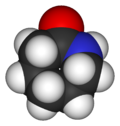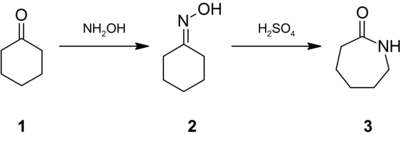Caprolactam
| |||
| Names | |||
|---|---|---|---|
| IUPAC name
Azepan-2-one
| |||
| Other names
ε-Caprolactam, 1-Aza-2-cycloheptanone, 2-Azacycloheptanone, Capron PK4, Cyclohexanone iso-oxime, Extrom 6N, Hexahydro-2-azepinone, Hexahydro-2H-azepin-2-one (9CI), Hexanolactame
| |||
| Identifiers | |||
3D model (JSmol)
|
|||
| ECHA InfoCard | 100.003.013 | ||
| EC Number |
| ||
PubChem CID
|
|||
CompTox Dashboard (EPA)
|
|||
| |||
| Properties | |||
| C6H11NO | |||
| Molar mass | 113.16 g/mol | ||
| Appearance | white solid | ||
| Density | 1,01 g/cm3 | ||
| Melting point | 68 °C | ||
| Boiling point | 136-138 °C @ 10 mm Hg | ||
| 820 g/L (20 °C) | |||
| Hazards | |||
| Flash point | 125 °C | ||
Except where otherwise noted, data are given for materials in their standard state (at 25 °C [77 °F], 100 kPa).
| |||
Caprolactam is an organic compound with the formula (CH2)5C(O)NH. This colourless solid, which is a lactam or a cyclic amide of caproic acid. Approximately 2 billion kilograms are produced annually. Caprolactam is the precursor to Nylon 6, a widely used synthetic polymer.[1]
Synthesis and production
Caprlactam was first described in the late 1800s when it was prepared by the cyclization of ε-aminocaproic acid, the product of the hydrolysis of caprolactam. Given the commercial significance of nylon-6, many methods have been developed for the production of caprolactam. Most of the caprolactam is synthesised from cyclohexanone (1), which is first converted to its oxime (2). Treatment of this oxime with acid induces the Beckmann rearrangement to give caprolactam (3):
The immediate product of the acid-induced rearrangement is the bisulfate salt of caprolactam. This salt is neutralized with ammonia to release the free lactam and cogenerate ammonium sulfate. In optimizing the industrial practices, much attention is directed toward minimizing the production of ammonium salts.
The other major industrial route involves formation of the oxime from cyclohexane using nitrosyl chloride. The advantage of this method is that cyclohexane is less expensive than cyclohexanone. In earlier times, caprolactam was prepared by treatment of caprolactone with ammonia.[1]
Uses
Caprolactam is the precursor to Nylon-6. The conversion entails a ring-opening polymerization:
- n (CH2)5C(O)NH → [(CH2)5C(O)NH]n
Nylon-6 is widely used in fibers and plastics.
Safety
Caprolactam is an irritant and is mildly toxic, with an LD50 of 1.1 g/kg (rat, oral). In 1991, it was included on the list of hazardous air pollutants by the U.S. Clean Air Act of 1990. It was subsequently removed from the list in 1993.[2] In water, caprolactam hydrolyzes to aminocaproic acid, which is used medicinally.
References
- ^ a b Josef Ritz, Hugo Fuchs, Heinz Kieczka, William C. Moran "Caprolactam" Ullmann's Encyclopedia of Industrial Chemistry, Wiley-VCH, Weinheim, 2002. doi:10.1002/14356007.a05_031
- ^ EPA - Modifications To The 112(b)1 Hazardous Air Pollutants
Further information
- The Nylon-6 Promotional Group website.[1]]



